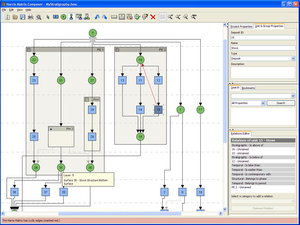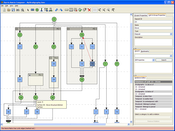Information
- Publication Type: Conference Paper
- Workgroup(s)/Project(s):
- Date: November 2008
- ISBN: 978-3-85161-016-1
- Series: Archäologie und Computer
- Publisher: Phoibos Verlag
- Organization: Museen der Stadt Wien – Stadtarchäologie
- Note: http://www.stadtarchaeologie.at/
- Location: Vienna, Austria
- Lecturer: Christoph Traxler
- Address: Rathaus, Friedrich-Schmidt- Platz 1, 1010 Vienna
- Editor: Wolfgang Börner, Susanne Uhlirz
- Booktitle: Kulturelles Erbe und Neue Technologien − Workshop "Archäologie und Computer"
- Conference date: 3. November 2008 – 5. November 2008
- Keywords: harris matrix, archaeological stratigraphy, graph theory
Abstract
The Harris Matrix - formulated by Dr. Edward C. Harris in 1973 - is the established way of representing the archaeological stratigraphy of an excavation. The Harris Matrix is a sequential diagram defining stratigraphic relations between stratigraphic units. It is an important method to document the stratification that is destroyed by the excavation process and hence a vital tool for stratigraphic analysis. Although the Harris Matrix has become a quasi standard of archaeological stratigraphy, only a few software tools exist to create and edit these diagrams. An evaluation of these tools showed that they do not completely comply with the theory or suffer from poor usability. Therefore we decided to develop a new application addressing these issues, called Harris Matrix Composer (HMC). Dr. Harris was involved in the evaluation of early prototypes to guarantee compliance with his theory. User tests were undertaken to discover and handle usability problems. The main component of the HMC is a graph editor with an intuitive graphical user interface for creating and editing a Harris Matrix throughout the entire stratigraphic excavation process. Users add graphical symbols that represent stratigraphic units (either deposits or surfaces) and determine their stratigraphic relations by drawing edges between two such symbols. The application supports valid Harris Matrix creation and indicates invalid units and relations. In addition to stratigraphic relations, temporal relations can be added by drawing special edges or grouping units into periods. Phases define structural relations, like posts or postholes of a dwelling. The HMC will be developed into a powerful interface to a GIS system, like ArcGIS to access single surface maps and related databases for visualization and stratigraphic analysis by selecting units of the Harris Matrix. In a similar way it will work together with the point cloud editor SCANOPY to filter these vast data sets. A trial beta version and further information is available at the web site: www.harrismatrixcomposer.comAdditional Files and Images
Weblinks
No further information available.BibTeX
@inproceedings{TRA08b,
title = "The Harris Matrix Composer - A New Tool to Manage
Archaeological Stratigraphy",
author = "Christoph Traxler and Wolfgang Neubauer",
year = "2008",
abstract = "The Harris Matrix - formulated by Dr. Edward C. Harris in
1973 - is the established way of representing the
archaeological stratigraphy of an excavation. The Harris
Matrix is a sequential diagram defining stratigraphic
relations between stratigraphic units. It is an important
method to document the stratification that is destroyed by
the excavation process and hence a vital tool for
stratigraphic analysis. Although the Harris Matrix has
become a quasi standard of archaeological stratigraphy, only
a few software tools exist to create and edit these
diagrams. An evaluation of these tools showed that they do
not completely comply with the theory or suffer from poor
usability. Therefore we decided to develop a new application
addressing these issues, called Harris Matrix Composer
(HMC). Dr. Harris was involved in the evaluation of early
prototypes to guarantee compliance with his theory. User
tests were undertaken to discover and handle usability
problems. The main component of the HMC is a graph editor
with an intuitive graphical user interface for creating and
editing a Harris Matrix throughout the entire stratigraphic
excavation process. Users add graphical symbols that
represent stratigraphic units (either deposits or surfaces)
and determine their stratigraphic relations by drawing edges
between two such symbols. The application supports valid
Harris Matrix creation and indicates invalid units and
relations. In addition to stratigraphic relations, temporal
relations can be added by drawing special edges or grouping
units into periods. Phases define structural relations, like
posts or postholes of a dwelling. The HMC will be developed
into a powerful interface to a GIS system, like ArcGIS to
access single surface maps and related databases for
visualization and stratigraphic analysis by selecting units
of the Harris Matrix. In a similar way it will work together
with the point cloud editor SCANOPY to filter these vast
data sets. A trial beta version and further information is
available at the web site: www.harrismatrixcomposer.com ",
month = nov,
isbn = "978-3-85161-016-1",
series = "Arch\"{a}ologie und Computer",
publisher = "Phoibos Verlag",
organization = "Museen der Stadt Wien – Stadtarch\"{a}ologie",
note = "http://www.stadtarchaeologie.at/",
location = "Vienna, Austria",
address = "Rathaus, Friedrich-Schmidt- Platz 1, 1010 Vienna",
editor = "Wolfgang B\"{o}rner, Susanne Uhlirz",
booktitle = "Kulturelles Erbe und Neue Technologien − Workshop
"Arch\"{a}ologie und Computer"",
keywords = "harris matrix, archaeological stratigraphy, graph theory",
URL = "https://www.cg.tuwien.ac.at/research/publications/2008/TRA08b/",
}


 Paper
Paper
